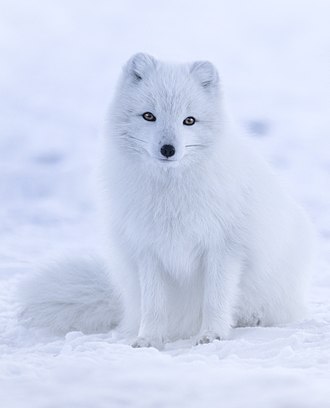The Arctic fox (Vulpes lagopus), also known as the white fox, polar fox, or snow fox, is a small fox native to the Arctic regions of the Northern Hemisphere and common throughout the Arctic tundra biome. It is well adapted to living in cold environments, and is best known for its thick, warm fur that is also used as camouflage. It has a large and very fluffy tail. In the wild, most individuals do not live past their first year but some exceptional ones survive up to 11 years.[9] Its body length ranges from 46 to 68 cm (18 to 27 in), with a generally rounded body shape to minimize the escape of body heat.
Arctic foxes must endure a temperature difference of up to 90–100 °C (160–180 °F) between the external environment and their internal core temperature. To prevent heat loss, the Arctic fox curls up tightly tucking its legs and head under its body and behind its furry tail. This position gives the fox the smallest surface area to volume ratio and protects the least insulated areas. Arctic foxes also stay warm by getting out of the wind and residing in their dens. Although the Arctic foxes are active year-round and do not hibernate, they attempt to preserve fat by reducing their locomotor activity. They build up their fat reserves in the autumn, sometimes increasing their body weight by more than 50%. This provides greater insulation during the winter and a source of energy when food is scarce.
The bovine tribe (Bovini) split about 5 to 10 million years ago into the buffalos (Bubalus and Syncerus) and a group leading to bison and taurine cattle. Genetic evidence from nuclear DNA indicates that the closest living relatives of bison are yaks, with bison being nested within the genus Bos, rendering Bos without including bison paraphyletic. The mitochondrial DNA of European bison is more closely related to that of domestic cattle and aurochs, which is either suggested to be the result of incomplete lineage sorting or ancient introgression. Bison are widely believed to have evolved from a lineage belonging to the extinct genus Leptobos during the Late Pliocene to Early Pleistocene in Asia. The earliest members of the bison lineage, known from the Late Pliocene to Early Pleistocene of the Indian Subcontinent (Bison sivalensis) and China (Bison palaeosinensis), approximately 3.4-2.6 million years ago (Ma) are placed in the subgenus Bison (Eobison). The oldest remains of Eobison in Europe are those Bison georgicus found in Dmanisi, Georgia, dated to around 1.76 Ma. More derived members of the genus are placed in the subgenus Bison (Bison), which first appeared towards the end of the Early Pleistocene, around 1.2 Ma, with early members of the subgenus including the widespread Bison schoetensacki.
The steppe bison (Bison priscus) first appeared during the mid-Middle Pleistocene in eastern Eurasia, and subsequently became widely distributed across Eurasia. During the late Middle Pleistocene, around 195,000-135,000 years ago, the steppe bison migrated across the Bering land bridge into North America, becoming ancestral to modern American bison, as well as extinct forms such as the largest known bison, the long-horned Bison latifrons, and the smaller Bison antiquus, which became extinct at the end of the Late Pleistocene. Modern American bison are thought to have evolved from B. antiquus during the Late Pleistocene-Holocene transition via the intermediate form Bison occidentalis. The European bison, Bison bonasus, first appeared in Europe during the late Middle Pleistocene, where it existed in sympatry with the steppe bison. Its relationship with other extinct bison species is unclear, though it appears to be only distantly related to the steppe and American bisons, with possibly some interbreeding between the two lineages during the Middle Pleistocene. The steppe bison survived into the early-mid Holocene in Alaska-Yukon and eastern Siberia, before becoming extinct.
The Arctic fox lives in some of the most frigid extremes on the planet, but they do not start to shiver until the temperature drops to −70 °C (−94 °F). Among its adaptations for survival in the cold is its dense, multilayered pelage, which provides excellent insulation. Additionally, the Arctic fox is the only canid whose foot pads are covered in fur. There are two genetically distinct coat color morphs: white and blue. The white morph has seasonal camouflage, white in winter and brown along the back with light grey around the abdomen in summer. The blue morph is often a dark blue, brown, or grey color year-round. Although the blue allele is dominant over the white allele, 99% of the Arctic fox population is the white morph. Two similar mutations to MC1R cause the blue color and the lack of seasonal color change. The fur of the Arctic fox provides the best insulation of any mammal.
The fox has a low surface area to volume ratio, as evidenced by its generally compact body shape, short muzzle and legs, and short, thick ears. Since less of its surface area is exposed to the Arctic cold, less heat escapes from its body.
The average head-and-body length of the male is 55 cm (22 in), with a range of 46 to 68 cm (18 to 27 in), while the female averages 52 cm (20 in) with a range of 41 to 55 cm (16 to 22 in). In some regions, no difference in size is seen between males and females. The tail is about 30 cm (12 in) long in both sexes. The height at the shoulder is 25 to 30 cm (9.8 to 11.8 in). On average males weigh 3.5 kg (7.7 lb), with a range of 3.2 to 9.4 kg (7.1 to 20.7 lb), while females average 2.9 kg (6.4 lb), with a range of 1.4 to 3.2 kg (3.1 to 7.1 lb).
